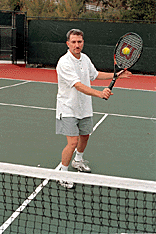
Go to Part 1 Part 2 Part 3 Part 4 Part 5 Part 6 Part 7 Part 8 of the Visual Tennis Series on TennisONE
(Click here to see animation of backhand volley)
In the Visual Tennis system, the volleys, like the groundstrokes, are based on simple, highly specific hitting arm positions. These positions are set up at the completion of the turn or preparation and remain unchanged throughout the course of the stroke pattern. Besides their simplicity, these positions are highly efficient, leading to consistency and natural power at the net.
Most teaching approaches, tennis tips, etc., never discuss the position of the hitting arm and the hand during the course of a stroke pattern. But this position is critical to good technique since it ultimately determines the position of the racket head when it contacts the ball.
In this article, we will teach you how to establish the classical hitting arm position for the backhand volley. The progression shown here demonstrates how to hit a basic flat volley. A subsequent article will show how to alter the hitting arm position slightly to create natural underpin or slice.
The shape of the backhand volley hitting arm position can best be described as an open "U" shape. The forearm is parallel to the court, forming the base of the "U". The upper arm and the racket are set at a 45-degree angle to the court, forming the "legs" of the "U".
This arm and hand position is set up at the completion of the preparation through a unit turn. The unit is comprised of a step or pivot sideways with both feet and a shoulder turn. On the volley the unit turn the player prepares the racket automatically. There is no additional movement with the arm or internal arm movement. The unit turn is the backswing.
Once this hitting arm position is established, it remains unchanged throughout the shot. The arm and racket move to the contact and then the finish in the same position. There is no arm or wrist motion in the "U." The player uses his shoulder and chest muscles to move the "U" forward to the ball as a unit. There is minimal to no torso rotation, so that the plane of the shoulders stays almost perpendicular to the net.
As on the groundstrokes the player who masters these key positions will naturally and automatically add a small elliptical loop to change the direction of the racket as it starts forward to the ball. But there is no need to key this or incorporate it into the core elements of the model.
Below the backhand volley and the corresponding hitting arm position are broken down into four key positions with specific checkpoints. The key images teach you how to achieve the open "U" bend hitting arm position for yourself, how to set it up at the completion of the preparation, and maintain it over the course of the swing.
For each position, establish the checkpoints physically, then create a mental image of how the position looks and feels inside your mind's eye. Practice executing the swing pattern in front of a mirror and then with your eyes letting the imagery guide you. Stop at each of the key positions, open your eyes and evaluate how close you are to the checkpoints.
Begin hitting balls in a controlled drill situation with an easy feed from a partner, teaching pro or, better yet, a ball machine.
As you begin the motion, visualize the image of the hitting arm at the turn and then the contact. Let your body follow the images as if they were an imaginary blueprint. The process of visualizing a key image can occur in the flash of a second--the time we actually have to hit a tennis ball, particularly at the net. Using these images in matches will give you a method to produce reliable classic backhand volleys under intense competitive pressure.

Ready Position. A good balanced ready position is critical to preparation at the net. Note that the tip of the racket is even with the top of the head, and the elbows are relaxed and slightly bent. The feet are a little wider than shoulder width and the knees are flexed.



- End of Part Nine -
Send email to the author
We encourage you to email your comments (pro, con, appreciative, whatever) directly to the author. To send email to John Yandell, click here.
To see John Yandell's Pro Tennis video series, go to: http://www.protennisvideo.com
Go to Part 1 Part 2 Part
3 Part 4 Part 5 Part
6 Part 7 Part 8 of the Visual Tennis Series
on TennisONE
Back To TennisONE Home Page
What's New | Tennis
Lessons | Tennis in Your
Area | Tennis Fitness
Tennis Products | Other
Tennis Sites | Sponsors/Advertisers/Consultants
|
Advertising
TennisONE© is a trademark of TennisONE© and SportsWeb ONE©.
Copyright© 1995. All rights reserved.